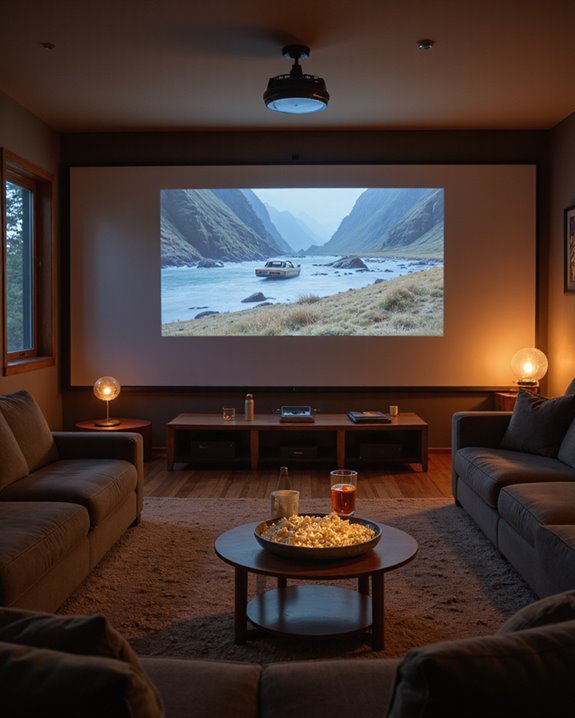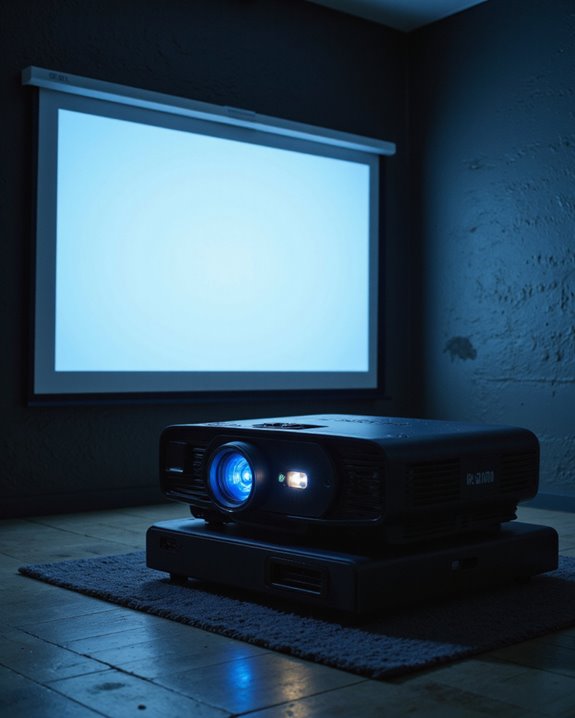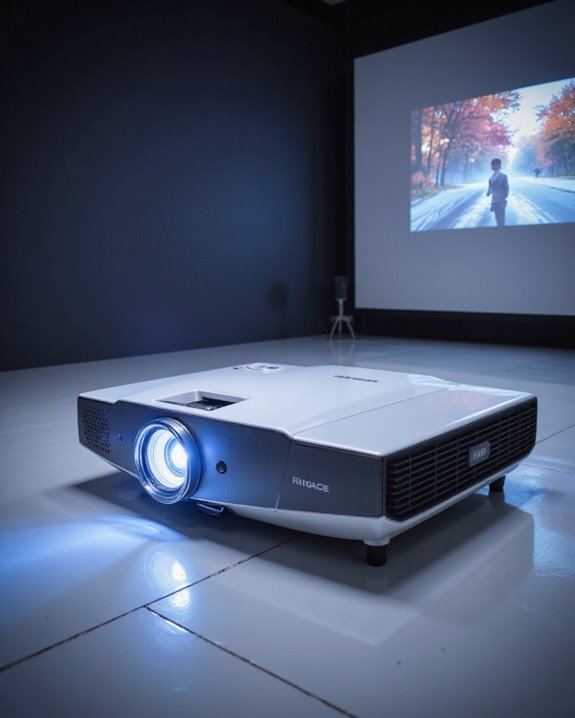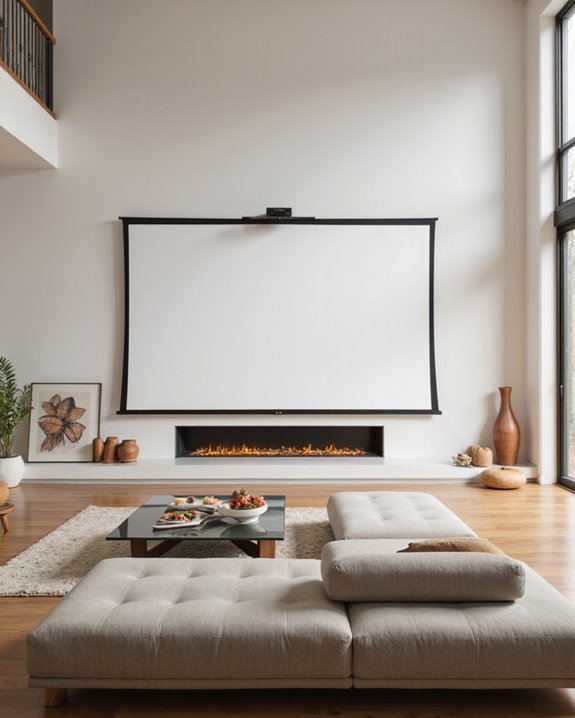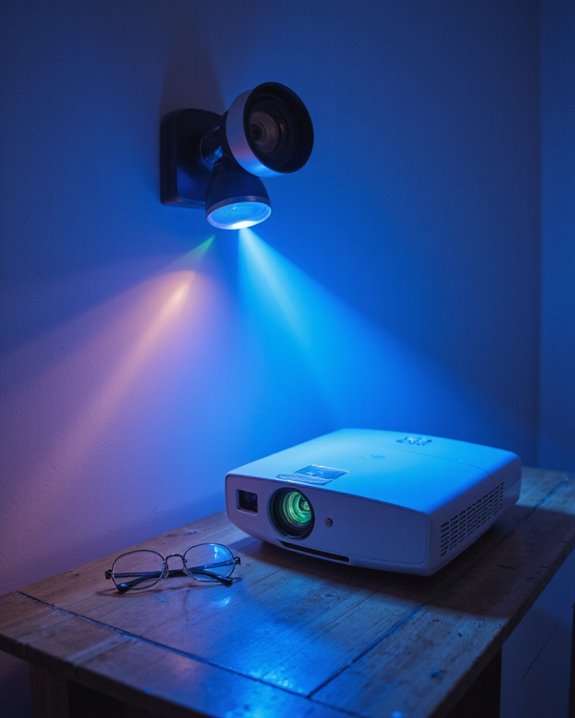Modern projectors can effectively replace TVs, according to Reddit users, particularly in dark rooms with controlled lighting. Projectors offer larger screen sizes (100+ inches) at lower costs compared to equivalent TVs, though they require more setup and maintenance. While gaming performance has improved markedly with low input lag (4.2ms), ambient light remains a challenge for daytime viewing. Smart features and streaming capabilities match TV functionality, but proper installation and room conditions determine success. Further exploration reveals important considerations for specific viewing scenarios.
Key Takeaways
- Projectors offer significantly larger screen sizes (100+ inches) at lower costs than TVs, making them ideal for cinema-like experiences.
- Ambient light significantly impacts projector performance, with many Reddit users noting the need for controlled lighting conditions.
- Modern gaming projectors achieve low input lag and high refresh rates comparable to TVs, satisfying most gamers’ needs.
- Setup complexity, maintenance requirements, and ongoing costs like lamp replacements are common drawbacks cited by Reddit users.
- Smart features and streaming capabilities match TV functionality, but users emphasize the trade-off between immersive viewing and practical convenience.
The Great Screen Size Debate: Bigger Really Is Better
When it comes to screen size, projectors offer a compelling advantage over traditional TVs by delivering substantially larger viewing areas at more affordable price points. While TVs are limited by their physical panel dimensions, projectors can easily display images exceeding 100 inches diagonally, creating screens up to 44% larger in total viewing area. The flexibility in mounting options allows projectors to adapt to various room sizes, though screen resolution becomes an important consideration at larger sizes. While 4K TVs maintain crisp image quality across their fixed dimensions, projector pixels spread across bigger areas can impact sharpness. However, for home theater enthusiasts seeking screens over 100 inches, projectors remain the only practical choice, as comparable TVs are either unavailable or prohibitively expensive, often costing tens of thousands of dollars. For maximum versatility, options like the Valerion Pro 2 can support projection from 80-130 inches, and advancements in image resolution continue to close the gap between large-screen TVs and projectors.
Brightness Battles: Ambient Light vs. Dark Room Performance
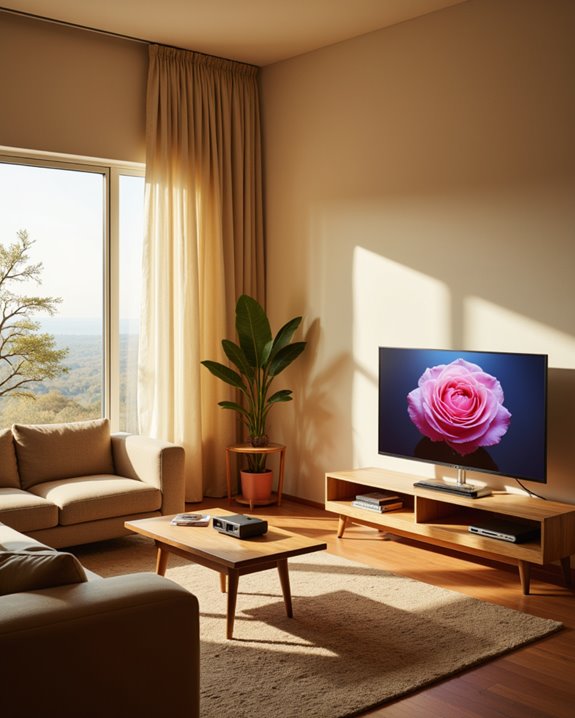
Although projectors can create impressive home theater experiences, their performance heavily depends on ambient light conditions in the viewing environment. In bright rooms, light bleed from windows and lamps can markedly reduce the contrast ratio – the difference between the brightest whites and darkest blacks on screen.
Most projectors perform ideally in dark rooms, where they can achieve vibrant colors and deep blacks without interference. Even high-lumen projectors, which measure 2,500 lumens or more, struggle to maintain image quality when competing with daylight. Experts recommend using projectors with 1,500 to 2,500 lumens for environments with moderate ambient light. While ambient light rejecting screens can help mitigate these issues, they don’t fully solve the problem. Additionally, selecting a projector with higher brightness levels can further improve daytime performance.
Viewers can improve their projection experience by:
- Installing blackout curtains
- Positioning the projector away from light sources
- Using screens designed for bright rooms
- Selecting higher-lumen projectors for daytime viewing
Gaming Performance: Input Lag and Response Time Reality Check
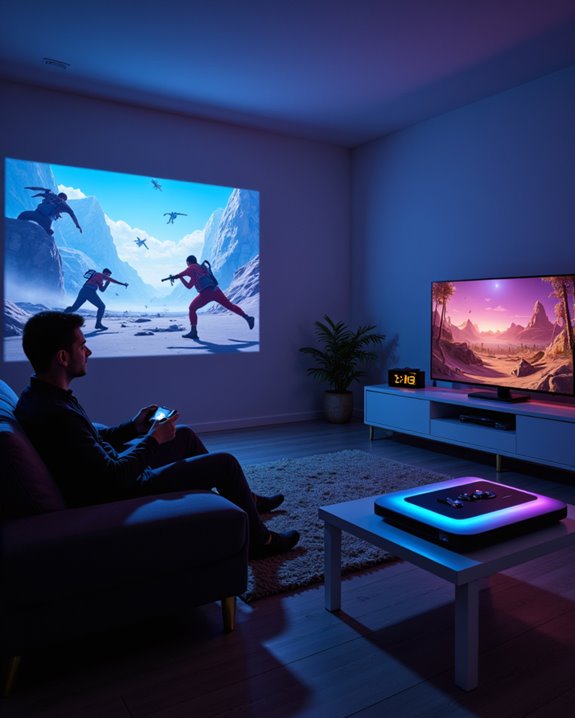
Since the rise of competitive gaming, input lag and response time have become essential factors for players choosing between projectors and TVs. Recent technological advances have dramatically improved projector performance, with high-end models achieving input lag as low as 4.2ms at 240Hz refresh rates. While TVs traditionally held the advantage in gaming responsiveness, modern projectors are closing the gap. Low latency technology now enables projectors to deliver quicker response times, making them more suitable for fast-paced gaming.
Both display types now offer compelling gaming features. TVs excel with their built-in HDR support and superior color accuracy, typically maintaining consistent input lag across different refresh rates. Meanwhile, DLP projectors utilize global shutter technology for nearly instant pixel response times, reducing motion blur in fast-paced games. Gaming-specific projector models can now achieve single-frame delay at 60Hz, with even better performance at higher refresh rates, making them viable alternatives for competitive gaming setups. The immersive theater experience created by projectors displaying games on screens over 100 inches provides a uniquely engaging way to play.
Cost Analysis: Dollar-Per-Inch Entertainment Value
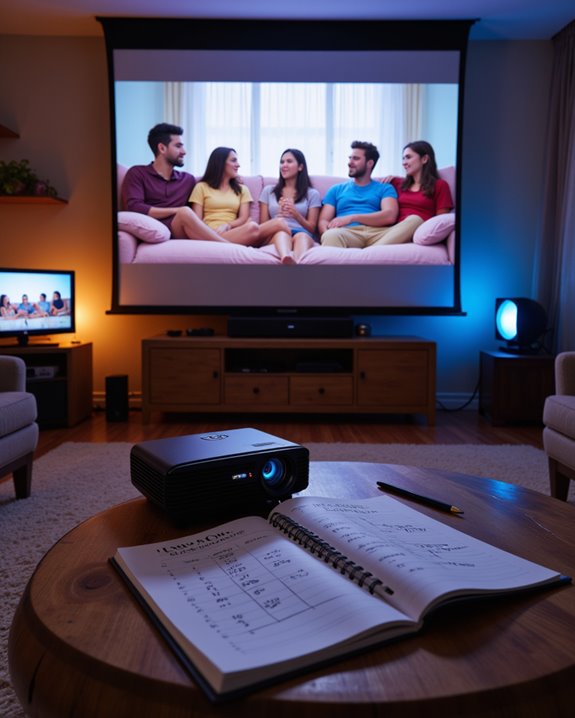
The financial comparison between TVs and projectors extends far beyond their initial price tags, especially when considering the cost per inch of screen size. While installation challenges and additional equipment needs can increase projector costs, they often deliver superior value for larger displays, offering screens up to 300 inches at a fraction of the cost of comparable TV sizes.
A detailed cost comparison reveals that projectors require ongoing maintenance, including lamp replacements and potential speaker systems. However, the dollar-per-inch advantage becomes more pronounced as screen sizes increase. Mid-range projectors typically provide more screen real estate for the money compared to similarly priced TVs. For home theater enthusiasts seeking massive displays over 100 inches, projectors consistently offer the most economical path to a cinema-like experience, despite their additional setup requirements. Investing in an ALR screen can significantly enhance picture quality and viewing experience while keeping costs lower than premium projector options.
Real-World Setup Challenges and Solutions
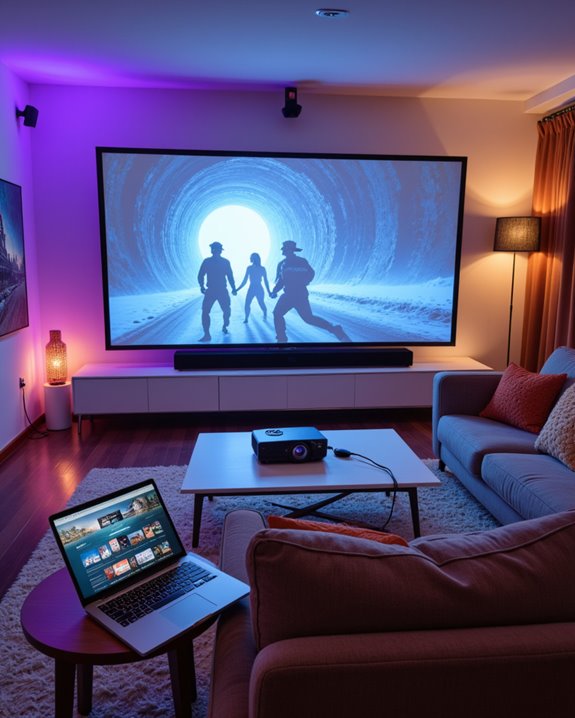
While projectors offer impressive large-screen experiences, setting them up presents distinct challenges that require careful planning and execution. From mounting challenges to ambient light control, users must consider multiple factors before replacing their TV with a projector system.
The setup complexity involves precise positioning for ideal image size and focus, along with managing cables and integrating audio equipment. Ultra short throw projectors can simplify some placement issues by requiring less room depth, but they still need careful calibration. Many users find that proper sound system integration becomes essential, as built-in projector speakers typically underperform compared to TV audio. At around $1,000 price point, most quality projectors offer comparable value to a 75-inch TV while providing larger screen sizes.
Room lighting poses another significant hurdle, often requiring blackout curtains or specialized screens to combat image wash-out during daylight hours. Regular maintenance, including bulb replacements and cleaning, adds another layer of consideration to the setup process.
Smart Features and Streaming Capabilities

Modern projectors have evolved substantially in their smart capabilities, matching many features traditionally associated with TVs. Today’s projectors come equipped with smart app integration, allowing users to access popular streaming services like Netflix and Hulu directly through built-in platforms such as Google TV or Android TV. By using compatible HDMI ports, users can transform basic projectors into full-featured streaming devices by connecting streaming sticks or media players.
Voice control functionality has become increasingly common in projectors, enabling users to navigate content and adjust settings hands-free through virtual assistants like Google Assistant or Alexa. The integration extends to smart home systems, making it possible to automate projector operations alongside other connected devices. While projectors offer similar streaming capabilities to TVs, including 4K resolution support and wireless connectivity options, they may require additional setup for ideal audio performance. Regular software updates ensure these smart features remain current and functional over time.
What Reddit Users Love (and Hate) About Projector Life
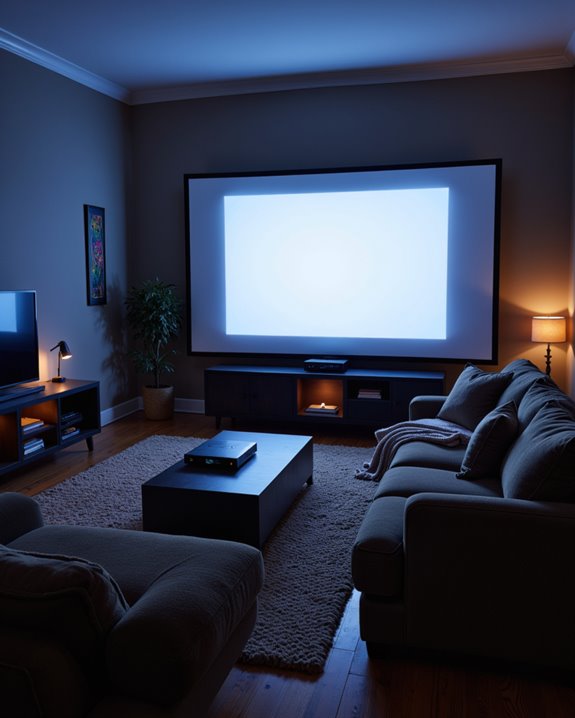
Reddit users consistently share diverse perspectives about their experiences with projector setups, revealing both enthusiastic praise and notable frustrations. Many celebrate the immersive experience of large-screen viewing during family gatherings and movie nights, while others express concerns about projector maintenance requirements and lamp replacement costs.
Common points of satisfaction include the flexibility to create cinema-sized displays and the ability to easily relocate equipment. Similar to how emotion analysis impacts economic decisions, user preferences for projectors often stem from emotional responses to their viewing experiences. However, users frequently mention challenges with audio integration and ambient light control. The Reddit community particularly emphasizes the importance of proper room setup, with many noting that dark spaces are essential for ideal viewing. While some users praise the cost-effectiveness of projectors for large displays, others point out that the ongoing maintenance and need for specific viewing conditions can make traditional TVs more practical for everyday use.
Frequently Asked Questions
How Long Do Projector Bulbs Typically Last Before Needing Replacement?
Purposeful projector performance varies: traditional bulbs typically last 2,000-4,000 hours before requiring replacement, while modern LED and laser light sources substantially extend bulb lifespan, functioning effectively for 20,000-100,000 hours of operation.
Can Projectors Damage Your Eyes When Looking Directly at Them?
Direct exposure to projector light can cause serious eye strain and potential damage. Safe viewing requires maintaining proper viewing angles and only watching projected content on screens, never looking directly into the light source.
Do Projectors Work Well for Watching Sports During Daytime Games?
Projectors can work for daytime sports, but ambient lighting considerably impacts image quality. Success depends on proper light control measures and screen size flexibility. High-brightness projectors and specialized screens offer the best viewing experience.
What’s the Minimum Distance Needed Between Projector and Screen?
The minimum projector distance depends on screen size and model type. Ultra-short throw projectors can work from 0.51 meters, while standard projectors typically need 8-12 feet for an 80-inch display, regardless of ambient light.
Are Projectors Louder Than TVS Due to Cooling Fans?
Projectors can sound like miniature jet engines compared to silent TVs. The sound level difference exists because projectors require active cooling fans to manage heat from their light sources, while modern TVs operate without fans.

